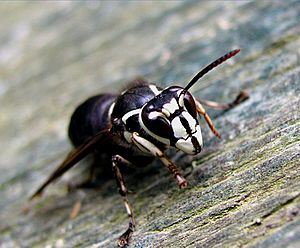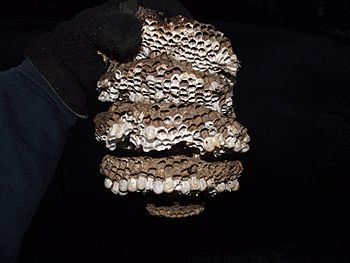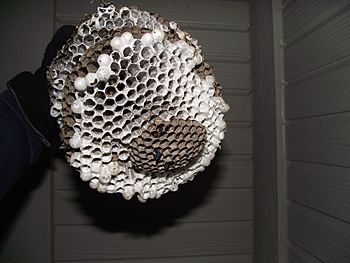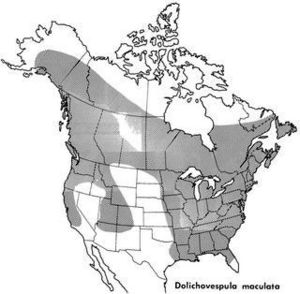Bald-faced hornet facts for kids
Quick facts for kids Bald-faced hornet |
|
|---|---|
 |
|
| Scientific classification | |
| Genus: |
Dolichovespula
|
| Species: |
maculata
|
| Synonyms | |
|
|
The Bald-faced hornet (scientific name: Dolichovespula maculata) is a type of wasp. It's known by many names like "white-faced hornet" or "blackjack." Even though it's called a hornet, it's actually a kind of yellowjacket wasp.
These wasps live in large groups called colonies. A colony can have 400 to 700 worker wasps! They build big, hanging paper nests that can be almost 60 centimeters (2 feet) long. Bald-faced hornets are very protective of their homes. They will sting many times to defend their nest if someone gets too close.
Bald-faced hornets live across the United States and southern Canada. They are most common in the southeastern parts of the U.S.
Contents
What is a Bald-faced Hornet?
The Bald-faced hornet gets its name from the white markings on its face. The word "bald" here comes from "piebald", which means having patches of two different colors. These wasps are easy to spot because of their black and white colors. Most other wasps in their group, Dolichovespula, are black and yellow.
Adult Bald-faced hornets are about 2 centimeters (0.75 inches) long. This makes them bigger than many other wasps in their group. The queen and the worker wasps look similar, but the queen is always larger.
Amazing Paper Nests
Bald-faced hornets build amazing, egg-shaped paper nests. These nests can be up to 35 centimeters (14 inches) wide and 58 centimeters (23 inches) long. Inside, the nest has layers of honeycomb-like cells. These cells are covered by a gray paper shell.
How do they make this paper? The hornets collect wood fibers, like from old wood fences or trees. They chew these fibers and mix them with their saliva. This creates a soft, pulpy material. They then shape this pulp into the nest walls, which dry into a strong, papery structure.
Where Do They Live?
Bald-faced hornets are found all over North America. This includes Canada, the Rocky Mountains, the western coast of the United States, and most of the eastern U.S. They are especially common in the southeastern states.
You can find these wasps in forests and in green areas within cities. They usually build their nests in trees and bushes. Sometimes, they might build them under rock overhangs or on the sides of buildings. Nests can be found from about 0.3 meters (1 foot) to 20 meters (65 feet) high off the ground.
Hornet Behavior
Bald-faced hornets eat both plants and other animals. They are helpful because they hunt and eat flies, caterpillars, and spiders. However, they can be a threat to humans if their nest is too close to homes or if someone disturbs it.
They are very aggressive when defending their nest. Worker wasps will sting repeatedly. But Bald-faced hornets have a special defense: they can spray venom from their stinger into the eyes of animals that threaten their nest. This venom can make eyes water and cause temporary blindness.
Life Cycle of a Colony
A Bald-faced hornet colony usually lasts for one year. It starts in the spring and ends in the fall.
Starting a New Colony
In the spring, a single queen who survived the winter starts a new nest. She builds the first part of the nest and lays her first eggs. She takes care of these first young wasps (larvae) by herself.
It takes about 6 days for the eggs to hatch into larvae. The larvae grow for about 8 days. Then, they spend another 9-10 days changing into adult worker wasps.
Growing the Colony
Once the first worker wasps are ready, they take over many tasks. The queen then focuses only on laying eggs. The workers build more cells for the nest and find food for the growing colony.
Later in the summer, the colony starts to produce new queens and males. These are the wasps that will fly off to mate and start new colonies next year. For a while, the colony raises both workers and future queens/males.
The workers have to bring in a lot of food for the young wasps and the new queens/males. They also protect the nest. If there aren't enough workers, the colony might not be able to produce many new queens and males.
Social Life of Hornets
A Bald-faced hornet colony has three types of wasps: the queen, female workers, and male wasps. All female wasps are born with the ability to lay eggs. However, usually only the queen lays eggs that become new queens or workers. Worker females can lay eggs that develop into males.
Queens are always bigger than workers in the same colony. The way a young wasp is fed determines if it will become a queen or a worker.
Wasps can recognize their nest mates. They do this by sensing special chemicals on the outer layer of their bodies, called cuticular hydrocarbons. These chemicals are like a unique scent for each nest.
What Do They Eat?
The diet of Bald-faced hornets changes as they grow and depending on where they live. Adult hornets are carnivores, meaning they hunt other insects. They eat flies, caterpillars, and spiders. They also eat meat, fruit, and drink flower nectar. Adults will bring nectar and chewed-up insects back to the nest to feed the young larvae.
Hornet Parasites
Sometimes, other insects try to live in hornet nests. Female bee moths (Aphomia sociella) are known to lay their eggs in Bald-faced hornet nests. When the moth eggs hatch, the larvae eat the hornet eggs, larvae, and pupae. They can cause a lot of damage to the nest as they tunnel through it looking for food.
The End of the Cycle
At the end of summer and in early fall, the queen lays eggs that will become new males and queens. These new, fertile males and females fly out of the nest to mate. The fertilized new queens then find a safe place to spend the winter. They will start new colonies the following spring.
The old queen, along with all the worker wasps and males, usually die by mid-autumn. Only the newly fertilized queens survive the winter to start the next generation.
|





